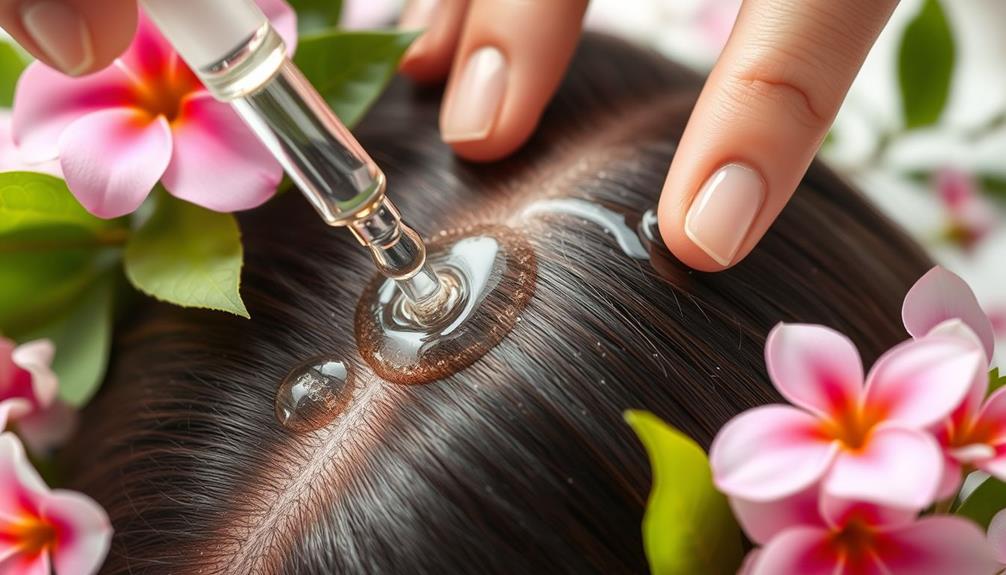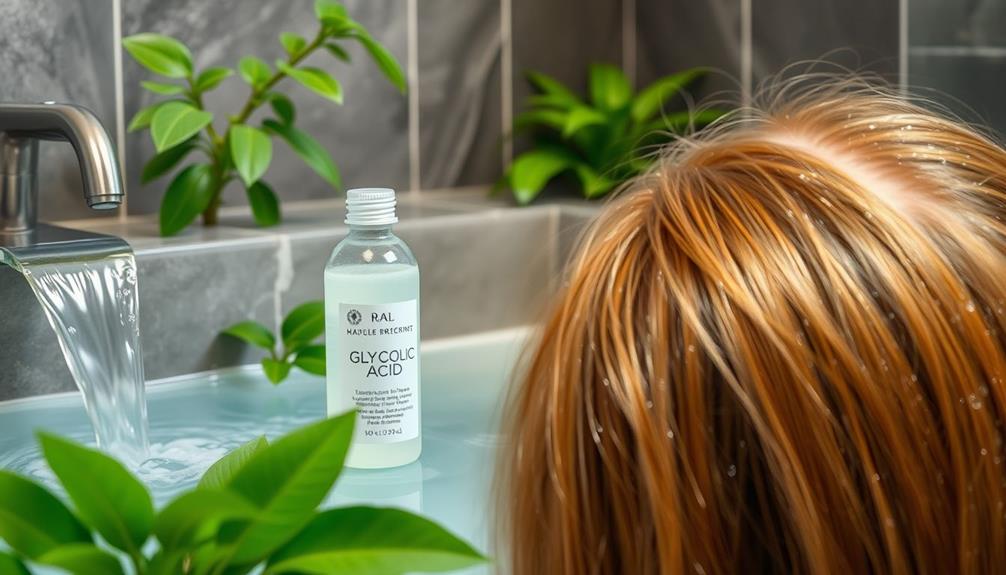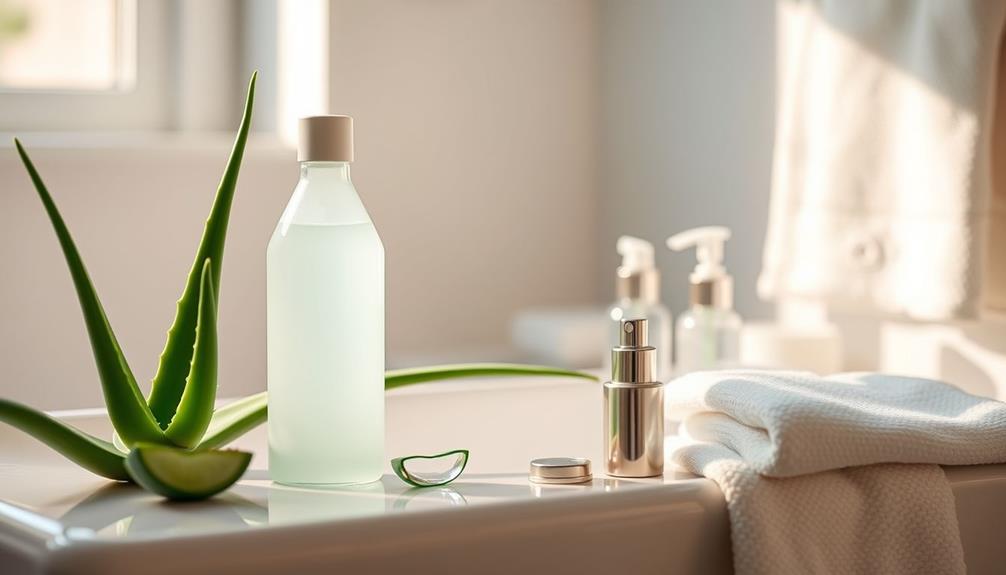Glycolic acid is transforming scalp care by effectively exfoliating and rejuvenating your scalp. This powerful ingredient breaks down dead skin cells and unclogs follicles, helping to reduce dandruff and excess oil. You’ll notice a fresher scalp and healthier hair as it enhances moisture retention and elasticity. Regular use can result in stronger hair strands, promoting overall scalp health. Whether you’re dealing with an oily scalp or simply want to enhance hair health, glycolic acid products can revolutionize your routine. Stay tuned to learn how its cutting-edge formulations are shaping the future of scalp care.
Key Takeaways
- Glycolic acid effectively exfoliates the scalp, removing dead skin cells and product buildup for improved scalp health.
- It enhances moisture retention and elasticity, promoting stronger, healthier hair growth over time.
- Regular use helps maintain a balanced scalp ecosystem, reducing dandruff and flakiness.
- Its ability to penetrate hair shafts improves hair structure, making hair shinier and more manageable.
Overview of Glycolic Acid

Glycolic acid, a powerful alpha hydroxy acid derived from sugarcane, excels at exfoliating the scalp and improving overall hair health. This effective ingredient penetrates hair follicles, breaking down the bonds between dead skin cells. By doing so, it promotes cell turnover, which is essential for maintaining ideal scalp health.
You'll find glycolic acid in various hair care products, typically in concentrations ranging from 5% to 10%. This concentration provides effective exfoliation without causing excessive irritation, making it suitable for most hair types.
In addition to its exfoliating benefits, incorporating essential oils like rosemary and lavender can further stimulate hair follicles and enhance scalp circulation.
One of the primary benefits of glycolic acid is its ability to reduce excess sebum and product buildup. When you incorporate products containing glycolic acid into your routine, you'll notice a cleaner scalp environment, which can lead to healthier hair growth.
Additionally, glycolic acid enhances moisture retention and elasticity in both hair and scalp tissues, contributing to a more vibrant appearance.
As you explore scalp treatments, remember that glycolic acid is a game changer, ensuring your scalp remains healthy while effectively exfoliating the scalp. Embrace this ingredient, and you may just transform your scalp care routine for the better.
Benefits for Scalp Health

When you use glycolic acid on your scalp, you're promoting exfoliation and renewal, which helps clear away dead skin cells and product buildup.
This process not only enhances moisture retention but also balances the scalp environment for healthier hair growth.
Additionally, incorporating regular scalp treatments can further improve overall hair health, making it essential to evaluate various options such as hair treatments for damaged hair.
With regular use, you can experience a more comfortable and resilient scalp, leading to stronger hair strands over time.
Exfoliation and Renewal
Exfoliating the scalp with glycolic acid helps shed dead skin cells and unclog hair follicles, promoting healthier hair growth and reducing dandruff. When you incorporate glycolic acid into your scalp care routine, you'll notice several key benefits:
- Enhanced Scalp Health: Regular exfoliation improves overall scalp conditions, leading to healthier hair growth. This process is akin to <a target="_blank" href="https://adsandseo.com">effective clustering</a> in SEO, where organizing content can enhance overall performance.
- Reduced Dandruff: Glycolic acid unclogs follicles, decreasing the risk of buildup that causes flakiness.
Glycolic acid's chemical exfoliation properties effectively diminish oiliness and flakiness, giving your scalp a fresher, cleaner feel.
By promoting the shedding of dead skin cells and product buildup, you're not just addressing surface issues but enhancing the overall health of your scalp. This leads to a more vibrant and thriving hair environment, where each strand can flourish.
Moisture and Balance
Achieving a balanced scalp environment is just as important as exfoliation, and glycolic acid plays a key role in promoting moisture retention and overall scalp health.
By stimulating hyaluronic acid production, glycolic acid helps maintain hydration levels, preventing dryness and ensuring your scalp stays nourished. This moisture boost is crucial for creating a healthy foundation for your hair.
Additionally, incorporating essential oils, such as Lavender and Tea Tree, can enhance the hydration and overall health of your scalp, supporting a calm and balanced environment essential oils for scalp care.
The exfoliating properties of glycolic acid work to remove dead skin cells and excess sebum, resulting in a balanced scalp that reduces oiliness and product buildup.
When your scalp is clear and unclogged, it promotes better hair growth and enhances overall hair quality. You'll notice stronger strands and reduced breakage as regular use improves scalp hydration.
In addition, increased hydration from glycolic acid fosters better collagen gene expression, which contributes to healthier skin quality on your scalp.
So, by incorporating glycolic acid into your scalp care routine, you're not just addressing excess oils or dryness—you're creating an environment that supports scalp health, moisture retention, and ultimately, the liveliness of your hair.
Embrace the benefits of glycolic acid for a balanced and hydrated scalp.
Mechanism of Action

Glycolic acid works by penetrating the hair shaft and scalp, breaking down the bonds between dead skin cells to promote cell turnover and healthier hair follicles. This powerful alpha hydroxy acid (AHA) facilitates several beneficial mechanisms, ensuring your scalp care routine is effective and rejuvenating. Incorporating practices that focus on self-exploration through body awareness can enhance your overall well-being, including hair health.
Here are a few key actions glycolic acid takes:
- Enhances Moisture Retention: By altering the internal structure of hair fibers, it helps retain moisture, leading to softer and more flexible hair.
- Improves Hair Elasticity: Glycolic acid reduces brittleness and strengthens hair strands, minimizing breakage.
Studies have shown that glycolic acid considerably penetrates hair fibers, demonstrating its ability to induce structural changes and improve moisture retention. This makes it a crucial component in scalp care, ensuring not just healthier hair follicles, but also overall hair vitality.
Product Application Guidelines

When using glycolic acid for scalp care, it's essential to follow specific application guidelines for best results.
Incorporating mindful practices can enhance your overall scalp health, making it important to maintain a healthy weight to reduce resistance risk.
You should apply it as a pre-shampoo treatment and limit usage to 1-2 times per week.
Let's break down the steps to guarantee you get the most out of your treatment.
Application Frequency Recommendations
To maintain ideal scalp health, use glycolic acid treatments 1-2 times a week, adjusting as needed based on your skin's sensitivity.
Over-exfoliation can lead to scalp reactions, so it's important to find a balance that works for you. If you have sensitive skin or open sores, limit your usage and consult a dermatologist before starting any treatment.
Here are some tips for determining your application frequency:
- Monitor your scalp reactions closely; if irritation occurs, consider reducing your frequency.
- Long-term users may find that monthly applications are sufficient if sensitivity increases.
Always remember to follow specific product instructions, as formulations can vary.
By adhering to these guidelines, you'll promote healthy scalp exfoliation without compromising your skin's integrity.
Keep your scalp's unique needs in mind, and adjust your glycolic acid usage accordingly for the best results!
Pre-Shampoo Treatment Steps
Applying the glycolic acid pre-shampoo treatment correctly can greatly enhance your scalp's health and renewal process. Start by shaking the bottle to guarantee the glycolic acid is well-mixed. You can apply the treatment on either a wet or dry scalp, but using the nozzle applicator allows for precise targeting. Focus on areas where buildup is most prevalent, making sure you cover all spots effectively.
Once applied, let the treatment sit for about 10 minutes. This duration is vital for the glycolic acid to work its magic by exfoliating dead skin cells and promoting scalp renewal. You might notice a tingling sensation, which is normal and indicates that the product is actively working.
After the treatment period, wash your hair as usual with your preferred shampoo and conditioner. This step will help remove the glycolic acid treatment and any loosened debris from your scalp, leaving it refreshed.
To maintain ideal scalp health without over-exfoliating, aim to use this pre-shampoo treatment 1-2 times per week. Regular use will enhance your scalp's overall condition and prepare it for healthier hair growth.
Safety Considerations

Glycolic acid is generally safe for topical use, but it's essential to exercise caution as sensitive individuals might experience irritation. To guarantee your safety while using glycolic acid for scalp care, consider the following recommendations:
- Patch Testing: Before applying glycolic acid to your scalp, perform a patch test on a small area to check for any adverse reactions.
- Consult a Dermatologist: If you have specific scalp concerns or conditions, it's wise to consult a dermatologist for personalized advice.
Additionally, avoid using glycolic acid on broken or compromised skin, as this could lead to further irritation.
After application, especially during the day, remember to apply sunscreen to safeguard your scalp from UV damage.
By taking these precautions, you can enjoy the benefits of glycolic acid while minimizing risks.
Always listen to your body, and if you notice any discomfort, discontinue use and consult a healthcare professional for guidance. Your scalp's health and safety should always come first.
Hair Type Suitability

Understanding your hair type is essential for determining if glycolic acid is the right choice for your scalp care routine.
If you have an oily or flaky scalp, glycolic acid can be a game-changer. It effectively exfoliates excess sebum and removes dead skin cells, promoting better scalp health.
However, if your scalp is sensitive or has open sores, you should be cautious. Glycolic acid may cause irritation in these cases, so it's vital to assess your skin's response.
Additionally, if your hair is color-treated or has undergone recent chemical treatments, you might want to skip glycolic acid altogether. The acidity can weaken your hair and lead to potential hair loss, especially with long-term use.
It's best to use glycolic acid treatments once or twice a week, adjusting based on how your scalp reacts.
Expert Recommendations

How can you guarantee the best results when adding glycolic acid to your scalp care routine? Following expert recommendations is key. Start by consulting with a dermatologist to ascertain glycolic acid suits your specific scalp condition. They can provide personalized advice that makes a real difference.
Here are a few essential tips to keep in mind:
- Introduce Gradually: Begin with a lower concentration and monitor how your scalp reacts. This helps you assess tolerance before increasing the strength or frequency.
- Avoid Mixing Exfoliants: Steer clear of using glycolic acid alongside other exfoliating agents, especially vitamin C. This minimizes the risk of irritation and maximizes effectiveness.
Clinical Evidence

Research supports the effectiveness of glycolic acid in enhancing scalp health, making it a valuable addition to your care routine. Clinical studies reveal that glycolic acid promotes cellular turnover and reduces dead skin buildup, resulting in healthier hair follicles. This exfoliating agent can also enhance moisture retention in the scalp, leading to stronger hair and reduced breakage.
Here's a quick overview of the clinical evidence surrounding glycolic acid in scalp care:
| Benefit | Evidence |
|---|---|
| Cellular Turnover | Promotes healthier hair follicles |
| Moisture Retention | Improves hair strength and reduces breakage |
| Sebum Production | Balances scalp environment |
| Thermal Properties | Enhances hair resilience |
| Overall Manageability | Increases scalp hydration |
Regular application of glycolic acid can lead to cumulative benefits, including improved hair manageability and hydration. By incorporating glycolic acid into your hair care routine, you're not just addressing surface issues; you're investing in the long-term health of your scalp and hair.
Market Trends

The hair care market is rapidly evolving, with glycolic acid emerging as a sought-after ingredient for its proven benefits in scalp health. As consumers become more aware of the importance of scalp care, products containing glycolic acid are gaining traction.
Here are a few trends driving this shift:
- Increased Demand: More consumers are looking for hair care products that specifically target scalp health.
- Clean Beauty Movement: There's a notable rise in interest for clean beauty products, with glycolic acid being favored for its gentle yet effective exfoliating properties.
This growing recognition of the role of scalp health in overall hair care regimens is pushing brands to innovate. Research shows that glycolic acid is becoming a popular choice among consumers who want chemical exfoliants that promote scalp health and enhance hair growth.
As these trends continue, expect to see even more glycolic acid-infused hair care products hitting the shelves.
Future of Scalp Care

As you look ahead in scalp care, expect innovative formulations that combine glycolic acid with sustainable ingredients for maximum effectiveness.
You'll likely see products designed not just to cleanse, but also to nourish your scalp, addressing diverse needs.
This shift towards multifunctional and eco-friendly solutions is set to redefine how you care for your hair and scalp.
Innovative Formulation Trends
Innovative formulations with glycolic acid are redefining scalp care, offering targeted solutions that enhance scalp health and promote vibrant hair growth. This powerful ingredient is making waves by providing effective exfoliation, unclogging hair follicles, and reducing product buildup for a healthier scalp environment.
Here are some trends you can expect:
- Targeted Treatments: New product lines are addressing specific concerns, like dandruff and oiliness, utilizing glycolic acid's exfoliating and antimicrobial properties.
- Gentler Alternatives: Chemical exfoliants, such as glycolic acid, are emerging as a kinder substitute for traditional physical scrubs, promoting scalp rejuvenation without irritation.
Sustainable Ingredient Practices
Glycolic acid's rise in scalp care reflects a growing commitment to sustainable ingredient practices, offering you an eco-friendly option that promotes both health and environmental responsibility. As consumers become more aware of their choices, incorporating sustainable ingredients like glycolic acid is a step towards cleaner beauty.
| Feature | Glycolic Acid | Traditional Ingredients |
|---|---|---|
| Source | Organic, biodegradable | Often synthetic |
| Exfoliation Type | Chemical (gentle) | Physical (harsh) |
| Environmental Impact | Low (eco-friendly) | High (may harm ecosystems) |
Glycolic acid not only provides effective scalp exfoliation but also reduces the need for harsh scrubs, which can damage both your scalp and the environment. Research shows that it enhances product performance, allowing brands to minimize synthetic additives. By choosing products with glycolic acid, you're supporting a shift towards natural and eco-friendly solutions in scalp care, aligning your beauty routine with sustainable practices. This commitment enhances scalp health and promotes hair growth while prioritizing the planet's well-being.
Frequently Asked Questions
What Happens if You Put Glycolic Acid on Your Scalp?
If you put glycolic acid on your scalp, it exfoliates dead skin, reduces oiliness, and promotes healthier hair growth. You'll notice improved scalp hydration, less dandruff, and stronger, more manageable hair over time.
Does Glycolic Acid Get Rid of Scalp Buildup?
Did you know that 80% of people experience scalp buildup? Yes, glycolic acid effectively gets rid of it by exfoliating the scalp, promoting a healthier environment that can lead to improved hair growth and manageability.
Is Glycolic Acid Good for Seborrheic Dermatitis on Scalp?
Yes, glycolic acid can be beneficial for seborrheic dermatitis on your scalp. It helps remove dead skin, reduces buildup, and promotes hydration, making your scalp healthier and potentially alleviating dryness and flakiness.
What Is the Effect of Using Glycolic Acid in Hair Care Products?
Imagine your hair shimmering with health. When you use glycolic acid in hair care products, you're reducing breakage, enhancing softness, and creating a vibrant scalp environment that promotes growth and shines with every strand.
Conclusion
Incorporating glycolic acid into your scalp care routine can truly make waves in your hair health journey.
With its ability to exfoliate and promote a balanced scalp environment, you're not just treating issues; you're setting the stage for vibrant, luscious locks.
As you embrace this innovative ingredient, remember that a little goes a long way.
So, don't miss the boat on exploring glycolic acid—your scalp will thank you, and your hair will shine like never before!










